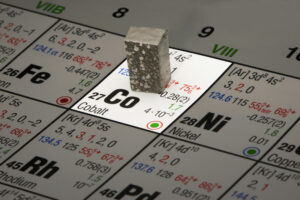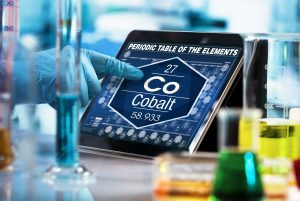Production
Cobalt and its compounds are largely mined as a by-product in nickel and copper deposits. Therefore, many sustainability indicators for metallic cobalt and cobalt compounds are difficult or impossible to determine. Pure cobalt mining sites account for only a small percentage, e.g. in the Democratic Republic of Congo. After the Congo, most cobalt is mined in in Indonesia and Russia. Most of the mining is done by open pit mining, but some cobalt is also mined underground. In addition, cobalt is extracted from overburden that was not used for cobalt extraction at the time of mining, but only for nickel or copper extraction. In general, an increasing demand for cobalt, especially for batteries, is forecasted. Approximately 40% of the cobalt produced worldwide is used outside the battery sector.
Resource consumption during processing
For the extraction of cobalt, rainforest is cleared in some countries, on the one hand to make mining areas accessible, on the other hand to secure shafts with the wood. During mining, there is a high consumption of water per ton of ore extracted. Energy consumption for processing the ore is high. The spoil heaps also cause high land consumption.
No renaturation or recultivation has taken place on many former mining areas (e.g. silted-up rivers). This is also due to the large number of smaller mining sites with different operators, with unclear responsibilities for recultivation.
Safety
There are reports of health hazards from dust generated during extraction in opencast mines. Inhalation causes lung irritation. As for other materials, the smaller the particles, the stronger the effect of the dust. Similarly, a skin sensitizing effect of cobalt and its compounds has been described. Cobalt is toxic to aquatic organisms in both the short and long term.
Other safety concerns with cobalt mining include transportation safety of degradation products (e.g., uranium and associated radioactivity) and process chemicals (e.g., acids). Pipeline leaks or accidents occasionally occur and can pose health hazards to the public. By-products of cobalt mining can include arsenic and radioactive uranium.
Emissions
CO2 emissions per ton of ore mined and processed amount to 20 – 620 kg CO2, depending on the deposit, whereby the actual mining and processing accounts for a small proportion of the overall balance. Around 80% of the cobalt mined worldwide is processed in China, resulting in further emissions from transport. The vehicles and machines used for mining cause about 50% of the CO2 emissions during extraction.
In addition to the high dust formation during ore mining, sulfur dioxide emissions ("acid rain") also occur during smelting, which are not removed by filter systems at all extraction sites. Acid mine drainage is produced during underground mining. As a result of past mining activities, many waters in the vicinity of extraction sites are contaminated with metals (e.g. arsenic). The overburden has led to the silting up of many rivers, which take decades to regenerate.
In some extraction sites, the overburden shows radioactivity due to a high uranium content.
Social Aspects
There are reports of child labour, particularly in informal small-scale mining. As a result, these children have health problems and poor educational opportunities. Accidents occur in unsecured tunnels. Corruption is also a problem. Small-scale miners have hardly any rights when dealing with middlemen (e.g. in price negotiations).
The entrepreneurial concentration of mining cobalt is considered high. This means that only a few benefit from the profits of cobalt mining. It is difficult to track the value added in the mining countries, but since China dominates further processing (refining), it can be assumed that most mining countries only earn from the material value.
The weighted country risk for the countries of origin of cobalt, based on the indicators of the World Bank (Worldwide Governance Indicators) shows a high risk. This means that there is a great need for improvement in, among others, political stability, voice, security and anti-corruption in many producing countries.
For responsible metal production, due diligence in supply chains is becoming increasingly important in the EU (Act on Corporate Due Diligence Obligations in Supply Chains). The law requires the documentation or certification of social standards and occupational health and safety, but initially only for companies with more than 3,000 employees.
Waste and recycling
Cobalt is currently still available in many deposits. Material recycling has so far only taken place to a small extent; in 2019, the rate was around 10%. However, this rate is expected to increase, also due to the legal requirements for recycling rates for batteries. The European Battery Regulation sets a recycling rate of 90% for cobalt in 2027. The recovery of cobalt from batteries allows direct reuse as cathode material (no downcycling). However, no complete recovery takes place.
How can the material be made more sustainable?
There is a trend towards partial or complete substitution of cobalt in cathodes, for example by the rare earth element neodymium. Using rechargeable batteries in electronic devices (e.g. smartphones) for longer or returning devices with rechargeable batteries for recycling contributes to sustainability.
CO2 emissions from vehicles and machinery during the extraction process should be reduced by electrifying fleets, although here, too, the share of the overall balance is small.
Greater transparency in supply chains is a key factor in promoting the social aspects of sustainability. Various international organizations are working on proofs of origin for cobalt (certifications), some of which are already being applied. These ensure that certain social and safety standards are met in the mining operations.
 As cobalt is used in some everyday applications, you may also come into frequent contact with it. Guitar strings and permanent magnets can contain cobalt. Tools that have to withstand particularly high loads also often contain cobalt (as tungsten carbide-cobalt). Cobalt improves the mechanical properties of prostheses, so you can have cobalt in your own body. Deep blue glass objects often contain cobalt as a colour pigment.
As cobalt is used in some everyday applications, you may also come into frequent contact with it. Guitar strings and permanent magnets can contain cobalt. Tools that have to withstand particularly high loads also often contain cobalt (as tungsten carbide-cobalt). Cobalt improves the mechanical properties of prostheses, so you can have cobalt in your own body. Deep blue glass objects often contain cobalt as a colour pigment. With more than 45% and thus the largest part of the cobalt production (as of 2017, and rising), cobalt now plays a decisive role as a component of the electrode material in nickel-metal hydride, nickel-cadmium and lithium-ion batteries. While the first lithium-ion batteries consisted of lithium-cobalt dioxide (LiCoO2), today so-called NMC (nickel-manganese-cobalt) lithium composite oxides are used. Efforts are increasingly being made to move away from cobalt, as it is sometimes mined under very questionable working conditions (child labour, slave labour). Nickel-cadmium and nickel-metal hydride batteries, which also contain cobalt, are on the market since a long time.
With more than 45% and thus the largest part of the cobalt production (as of 2017, and rising), cobalt now plays a decisive role as a component of the electrode material in nickel-metal hydride, nickel-cadmium and lithium-ion batteries. While the first lithium-ion batteries consisted of lithium-cobalt dioxide (LiCoO2), today so-called NMC (nickel-manganese-cobalt) lithium composite oxides are used. Efforts are increasingly being made to move away from cobalt, as it is sometimes mined under very questionable working conditions (child labour, slave labour). Nickel-cadmium and nickel-metal hydride batteries, which also contain cobalt, are on the market since a long time.